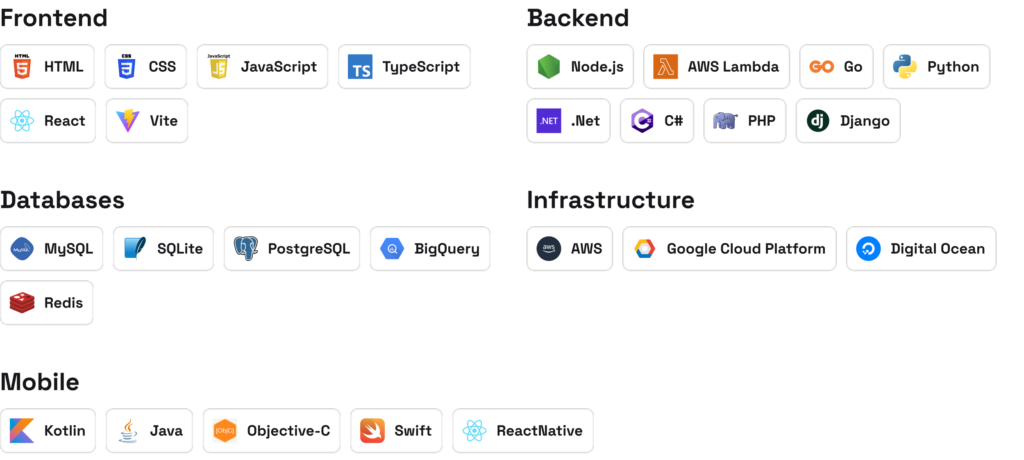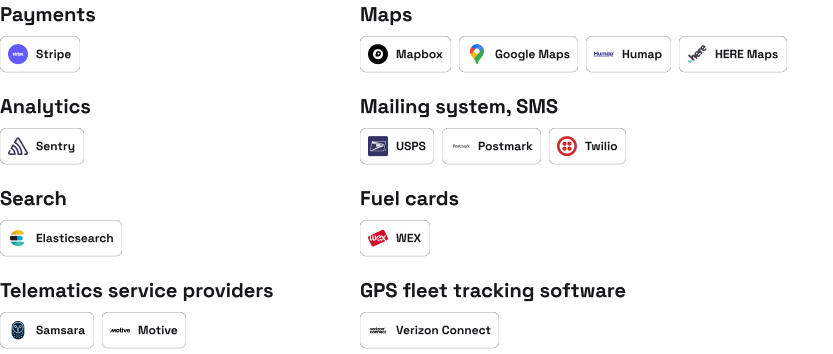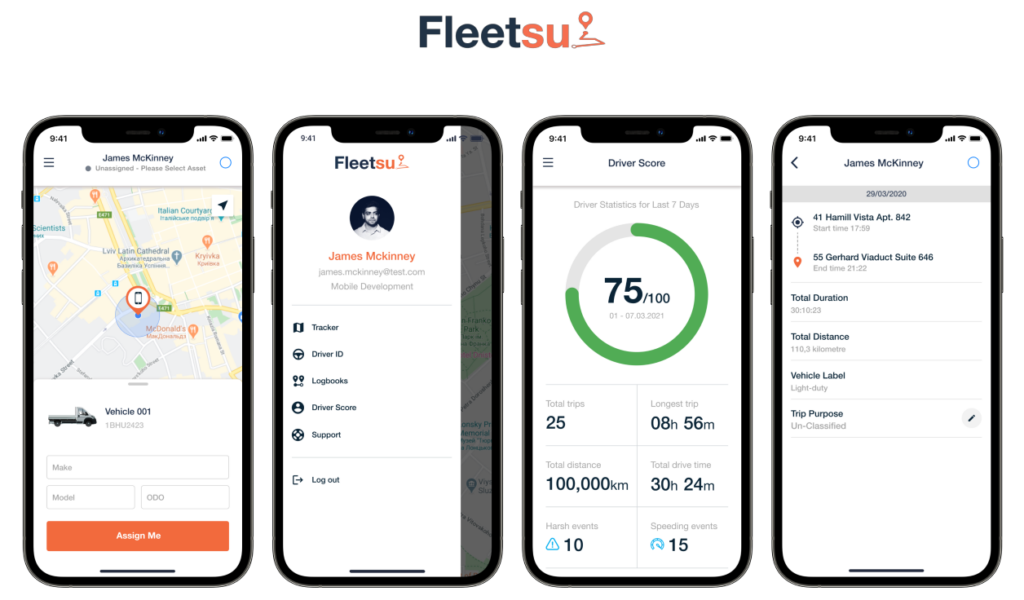In a rapidly evolving world, the fleet management solutions sector isn’t just keeping pace – it’s sprinting ahead. With a market value of approximately $24.48 billion in 2023, it’s poised to double in the next five years. What’s driving this explosive growth? A fusion of technological advancements and ever-growing transportation demands. The current state of fleet management software, with its integration of cutting-edge AI, IoT, and data analytics, is revolutionizing how fleets operate.
For over 7 years, our skilled team has been providing custom fleet management software development services, combining cutting-edge technology and industry expertise to deliver tailored solutions for our clients. And we decided to conduct research on the very heart of this booming sector, seeking to understand its nuances, challenges, and the underlying currents shaping its future.
This ‘State of fleet management software report‘ is more than just an analytical document; it’s a chronicle of the industry’s evolution, challenges, trends, and impact of global crises, offering valuable insights for businesses and professionals in the fleet management sector. With insights from 13 leading companies, our research offers not just raw data, but a comprehensive analysis of the current state of the fleet management industry.
This article serves as a snapshot of our comprehensive research, aiming to offer readers a condensed yet rich overview of where the fleet management software sector stands today, and where it’s headed tomorrow. And if you’re considering building a custom fleet management system for your business, we’d be delighted to answer any questions you might have. Please reach out to us at info@volpis.com
Key insights from industry research report: state of fleet management software in 2023
Through comprehensive interviews with C-level executives and marketing experts from 13 leading companies in the industry, we’ve secured exclusive insights on the current technologies, industry trends, and pressing challenges in the realm of fleet management.
Outsource vs in-house vs hybrid: how companies approach fleet management software development
Companies today are diversifying their team structures to best meet their software development needs. Based on our research:
- Outsourcing: 23% of companies prefer this model, driven by the potential for cost savings and access to a wider talent pool.
- In-house: 31% choose this approach, valuing the direct oversight, team cohesion, and inherent knowledge of company culture.
- Hybrid: standing out as the most popular choice, 46% of companies chose this approach because of its flexibility in team scaling, cost-effective use of both internal and external resources, and on-demand access to specialized skills.
The varied preferences underscore the evolving dynamics of software development, where companies prioritize flexibility, cost-effectiveness, and access to expertise.
Tech stack in use

With fleet management being a sector that thrives on real-time data, seamless operations, and high adaptability, it’s crucial to understand what technologies industry leaders are gravitating toward. Based on our findings:
Frontend
- HTML: The foundational language for web content, ensuring universal compatibility across browsers.
- CSS: Essential for styling web interfaces and ensuring optimal user experience by making content visually appealing.
- JavaScript: Powers dynamic interactivity on web pages, enhancing user engagement and interface responsiveness.
- TypeScript: A superset of JavaScript, it brings static typing to ensure code reliability and easier debugging.
- React: Chosen for its component-driven approach, making UI development more modular and maintainable.
- Vite: Gaining traction for its speed and efficiency in development, reducing build times and streamlining the development process.
Backend
- Node.js: Favored for its non-blocking, event-driven architecture, ensuring scalable network applications.
- AWS Lambda: Allows businesses to run code without provisioning servers, thus ensuring cost efficiency and scalability.
- Go: Its concurrency support makes it ideal for tasks that require performance and efficiency.
- Python: A versatile language, it’s often picked for its ease of learning and wide-ranging libraries.
- .Net & C#: They offer a robust and secure environment for building web applications.
- PHP: Popular for its simplicity and efficiency in web development.
- Django: Chosen because of its rapid development capabilities and a clean design.
Databases
- MySQL: A tried-and-true relational database system, known for its reliability and robustness.
- SQLite: Offers a lightweight, serverless, self-contained system.
- PostgreSQL: Chosen for its extensibility and standards compliance.
- BigQuery: Preferred for handling and analyzing big data, offering real-time insights.
- Redis: Adopted for its high performance, acting as a cache and broker.
Infrastructure
- AWS: Renowned for its extensive suite of tools, scalability, and reliability.
- Google Cloud Platform: Favored for its machine learning capabilities and vast service offerings.
- Digital Ocean: Known for its simplicity, catering especially to developers and startups.
Mobile
- Kotlin: Becoming the gold standard for Android development due to its concise and expressive syntax.
- Java: Continues to be a staple owing to its rich libraries and Android’s legacy codebase.
- Objective-C: Historically vital for iOS development, still present in legacy systems.
- Swift: Apple’s modern language, offering performance and safety features.
- ReactNative: Enables cross-platform mobile app development, allowing businesses to use the same codebase for iOS and Android, saving time and resources.
It’s evident that businesses are making judicious choices in their technology stack. These decisions aren’t mere trends; they reflect a deep understanding of user needs, business objectives, and the ongoing pulse of technological advancements.
Most popular third-party API or services

In today’s fleet management landscape, third-party APIs and services have emerged as vital cogs in the operational machine, empowering businesses with specialized functionalities without the overhead of developing these solutions from scratch. As the industry leans towards a more integrated and automated ecosystem, choosing the right third-party services becomes pivotal. The services not only need to be robust and reliable but also need to seamlessly integrate with existing infrastructures. Let’s explore which third-party solutions are leading the pack and why:
Payments
- Stripe: Recognized for its comprehensive suite of tools that simplify online payments, ensuring swift and secure transactions for businesses.
Analytics
- Sentry: An indispensable tool for real-time error tracking, Sentry provides actionable insights, helping businesses stay ahead of issues and maintain optimal system health.
Search
- Elasticsearch: Championed for its ability to handle vast amounts of data and provide lightning-fast search capabilities, ensuring that businesses can quickly access the information they need.
Fuel cards
- WEX: A standout in the realm of fuel management, WEX offers integrated fuel payment solutions, streamlining operations and expenses.
Maps
- Mapbox: Esteemed for its customizable maps and location-based solutions, enhancing route optimization and visualization.
- Google Maps: A household name that offers comprehensive mapping solutions, ensuring accurate route plotting and location intelligence.
- Humap: An emerging player, offering unique mapping solutions tailored for specific industry needs.
- HERE Maps: Known for its real-time traffic data and extensive location services, providing precise navigation insights.
Mailing system, SMS
- USPS: The age-old mailing system remains relevant by offering reliable mailing solutions.
- Postmark: A favorite for its rapid email delivery services, ensuring timely communication.
- Twilio: A frontrunner in the communication space, Twilio facilitates SMS, voice, and other communication services, guaranteeing connectivity.
GPS fleet tracking software
- Verizon Connect: Standing tall in the realm of fleet management, it provides end-to-end tracking solutions, ensuring real-time data insights and optimized fleet operations.
Telematics service providers
- Samsara: Recognized for its comprehensive telematics solutions, Samsara empowers businesses with real-time vehicle insights.
- Motiv: Gaining traction for its innovative approach, Motiv offers telematics solutions tailored to unique fleet needs.
Leveraging these third-party solutions doesn’t just streamline operations; it propels businesses forward, arming them with the functionalities they need to excel.
Challenges with fleet management software
As the fleet management industry moves towards advanced technological solutions, it’s met with a set of obstacles that can hinder optimization. Here are some of the most pressing challenges faced by companies in this realm:
Challenge 1: Data integrations of other systems and hardware
As fleet management systems interface with various other tools and hardware devices, seamless integration becomes imperative. A lack of effective integration can lead to data discrepancies, hampering decision-making processes.
Challenge 2: Resistance or low adoption rate of digital solutions
Despite the clear benefits of digital transformation, there’s often resistance, either due to lack of training, cultural challenges within organizations, or apprehensions about technology. This can slow down the pace of tech adoption, affecting operational efficiency.
Challenge 3: Adapting older solutions to be scalable and flexible
Legacy systems, built in a time with different technological standards and requirements, can prove to be inflexible in today’s dynamic environment. Modifying these systems to be scalable and adaptable to new technologies is both a challenge and a necessity.
Understanding these obstacles is crucial for businesses as it informs their strategies, ensuring they remain ahead of the curve. By addressing integration issues, driving digital adoption, and modernizing legacy systems, companies can position themselves at the forefront of fleet management innovation.
The rise of artificial intelligence
The transformative potential of AI is undeniable, with its ability to process vast amounts of data, provide actionable insights, and automate complex tasks. The surge in AI’s popularity is a testament to its role in driving operational excellence and ensuring a competitive edge in the fleet management sector. Here’s a glimpse into how businesses are embracing AI:
Current AI adoption
A significant 9 out of 13 companies have already embraced AI, incorporating it into their core operations and reaping its multifaceted benefits.
Researching AI’s potential
5 out of 13 companies are actively exploring the capabilities of AI, recognizing its transformative potential and strategizing its integration for future benefits.
Future outlook
A near-unanimous sentiment resonates among companies, with 12 out of 13 firms planning to integrate or expand their use of AI by 2024. This reflects a broader industry consensus on AI’s pivotal role in the future of fleet management.
The most prevalent applications of AI in fleet management are driver behavior monitoring for enhanced safety and streamlining operations through workflow automation. For businesses looking to remain at the vanguard of industry developments, embracing AI is not just a trend – it’s an imperative. As AI continues to redefine efficiency, safety, and productivity standards, it’s paramount for companies to harness its potential to drive unparalleled growth and innovation.
Implementing machine learning in fleet management
Machine Learning (ML) is more than just a buzzword in the fleet management realm. It’s an essential tool that businesses are rapidly adopting to refine operations, make accurate predictions, and streamline processes. Let’s deep dive into the data to understand this trend:
ML Integration
An impressive 9 out of 13 companies have already harnessed the power of ML, integrating it into their systems to drive efficiencies and gain actionable insights.
Exploring ML’s capabilities
With 3 out of 13 companies currently researching ML’s potential, it’s evident that there’s a growing intrigue and acknowledgment of the vast opportunities it holds.
The road ahead
A resounding consensus has emerged among industry leaders, with 12 out of 13 gearing up to either initiate or expand their ML ventures by 2024. This underlines the fact that ML isn’t just a passing trend; it’s set to be a mainstay in the industry.
Machine learning is predominantly used for predictive maintenance, forecasting demand, and optimizing routes in fleet management. ML is more than just a buzzword in fleet management; it’s a game-changer. The companies that harness its power early on, tapping into its predictive capabilities and data-driven insights, will be the ones steering the industry into a new era of innovation and strategic growth.
Top tech trends
As we move forward, the fleet management sector is poised for transformative changes, driven by technological advancements. Here’s a snapshot of the significant tech trends that are anticipated to reshape the fleet management landscape:
Use of AI
The use of Artificial Intelligence is set to become even more pervasive, refining operations, optimizing routes, and delivering actionable insights that enhance efficiency and reduce costs.
Operational automation
Automation will be at the forefront, reducing manual interventions, streamlining processes, and ensuring more reliable and consistent outcomes.
Vehicles electrification
The push towards sustainability will see a surge in vehicle electrification. This transition won’t just be about reducing carbon footprints but also about leveraging electric vehicles’ efficiency, lower maintenance costs, and performance benefits.
Increase the use of telematic devices & unification of databases
An increased emphasis on telematic devices is predicted, offering businesses real-time data on vehicle locations, condition, and driver behavior. Coupled with this is the expected unification of databases, ensuring seamless data flow, enhanced analytics, and superior decision-making capabilities.
Businesses that stay abreast of these trends, invest in innovation, and adapt proactively will undoubtedly lead the pack, setting new benchmarks and driving the industry into a future characterized by efficiency, sustainability, and intelligence.
Industry trends
Beyond the digital sphere, the very fabric of fleet management is evolving, reflecting a deeper transformation in industry ethos and paradigms. Leading companies and their management have weighed in, shedding light on the macro-level shifts anticipated to redefine the industry’s contours. Here’s an overview of the overarching industry trends that are gaining traction:
Business operations changes
Businesses are not just looking to enhance their operations, but to transform them entirely. This includes optimizing current processes and even diversifying their offerings, ensuring they remain agile and responsive to the dynamic market landscape.
Businesses consolidation
A wave of business consolidations is on the horizon. As companies seek to bolster their market position, merge resources, and tap into synergies, we can expect a series of mergers, acquisitions, and strategic alliances.
Sustainability as standard
No longer just a buzzword, sustainability is being integrated at the very core of business strategies. Companies are embracing eco-friendly practices, not just in vehicle choices but in every aspect of their operations, from supply chains to end-of-life vehicle management.
The fleet management industry stands at an inflection point, with companies pivoting and adapting to these emerging trends. Embracing these shifts is not just about staying relevant; it’s about leading the way in a future where efficiency, unity, and sustainability are the guiding stars.
Resilience & renaissance: the fleet management industry amidst global crisis
Despite supply chain issues, most companies experienced growth during the years 2021 to 2023. With global uncertainties looming large, it’s inspiring to observe how companies in the sector responded, pivoted, and sometimes even thrived. Here’s an analysis of the key industry trends during these turbulent times:
Unexpected upsurge
Contrary to initial apprehensions, a majority of companies reported growth, be it in terms of team expansion, increased clientele, or revenue spikes. This growth, in the face of adversity, is a testament to the sector’s resilience and adaptability.
Fiscal frictions
Not all sailed smoothly. Many faced financial hurdles, with some experiencing budget cuts or grappling with challenges in fundraising. Navigating these economic shoals required innovative strategies and sometimes painful adjustments.
Supply chain struggles
One of the most palpable impacts of the global crisis was on supply chains. Delays, disruptions, and dependencies affected operations, pushing companies to reevaluate and rethink their supply chain strategies, partnerships, and contingency plans.
The fleet management industry, with its mix of challenges and triumphs, emerged with invaluable lessons that will shape its trajectory for years to come, emphasizing the importance of agility, foresight, and resilience.
The growth hurdles: challenges in scaling the software development team
In the race to innovate and deliver, companies often face the imperative of expanding their software development teams. While scaling brings the promise of enhanced capabilities and quicker turnarounds, it’s not without its pitfalls. Many businesses have voiced common concerns and challenges they encounter when taking this pivotal step. Here’s a dive into the primary hurdles they face:
Challenge 1: Financial constraints
Striking the right balance between quality and affordability is a tightrope walk. Companies often grapple with finding talents that align with their budget constraints, ensuring they get the right price-to-quality ratio.
Challenge 2: Onboarding difficulties
Integrating newcomers into the existing team environment, culture, and project dynamics can be daunting. Effective and efficient onboarding processes are crucial, but perfecting them remains a challenge for many.
Challenge 3: Limited pool of talents
The competitive landscape means there’s a constant scramble to secure top talents. With a limited pool of seasoned professionals available, companies face intense competition, often vying for the same individuals.
Scaling a development team is a complex endeavor, fraught with challenges that demand strategic thinking, resourcefulness, and patience. For companies to scale successfully, it’s essential to anticipate these challenges, devise robust strategies to tackle them and ensure that the growth trajectory aligns with the overall organizational vision and goals.
How Volpis helps companies develop custom fleet management systems
Regularly ranked among the Top Custom Software Development Companies on Clutch.co, Volpis has been leveraging the power of technology to assist business owners in reaching unparalleled milestones. Our team, comprising 35+ in-house experts, has contributed to the design and development of over 100 web and mobile applications worldwide. Please check out our portfolio for a closer look at our successful projects and the innovative systems we’ve developed for our clients.
As an example, recently, we had the privilege of developing a state-of-the-art mobile location-tracking app called FleetSu for our customer. FleetSu revolutionizes fleet management by providing real-time vehicle tracking, insightful analytics, and efficient communication tools. It boasts an intuitive user interface and customizable dashboards, empowering managers to closely monitor their fleet and make well-informed decisions.

And if you’re planning to develop custom software solutions for your business, you may find this guide for building fleet management software useful. Check out our comprehensive resource to learn about trends, best practices, costs involved and so much more.
If you have any questions about fleet management technology or building a custom software system for your business, please don’t hesitate to reach out to us via info@volpis.com to schedule a free, no-commitment consultation.

Kostya Khuta, the CEO of Volpis, is an expert in crafting custom software solutions for the Fleet Management, Logistics, and Transportation industry. With over 8 years of experience, he leads the way in delivering innovative and tailored solutions to meet industry-specific needs.





